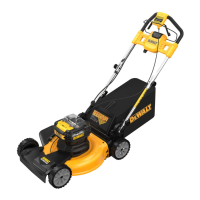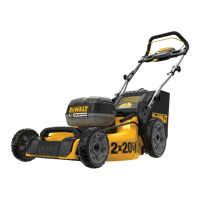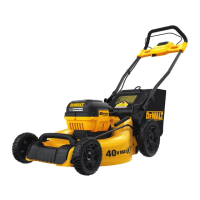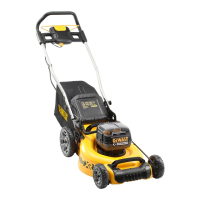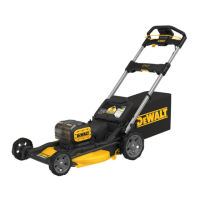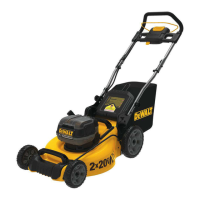ENGLISH
16
Register Online
Thank you for your purchase. Register your product nowfor:
• WARRANTY SERVICE: Registering your product will
help you obtain more efficient warranty service in case
there is a problem with yourproduct.
• CONFIRMATION OF OWNERSHIP: In case of an
insurance loss, such as fire, flood or theft, your registration
of ownership will serve as your proof ofpurchase.
• FOR YOUR SAFETY: Registering your product will
allow us to contact you in the unlikely event a safety
notification is required under the Federal Consumer
SafetyAct.
• Register online at www.dewalt.com.
Repairs
The charger and battery pack are notserviceable. There are
no serviceable parts inside the charger or batterypack.
WARNING: To assure product SAFETY and RELIABILITY,
repairs, maintenance and adjustment (including brush
inspection and replacement, when applicable) should
be performed by a DeWALT factory service center or a
DeWALT authorized service center. Always use identical
replacementparts.
Accessories
WARNING: Since accessories, other than those offered
by DeWALT, have not been tested with this product, use
of such accessories with this tool could be hazardous.
To reduce the risk of injury, only DeWALT recommended
accessories should be used with thisproduct.
Recommended accessories for use with your tool are
available at extra cost from your local dealer or authorized
service center. If you need assistance in locating any
accessory, please contact DeWALT call 1-800-4-DeWALT
(1-800-433-9258) or visit our website: www.dewalt.com.
Meets CPSC Safety Requirements
DeWALT Mowers conform to the safety standards of
the American National Standards Institute, and the U.S.
Consumer Product Safety Commission. The blade turns when
the blade motor isrunning.
Corrosion (Fig. A)
Fertilizers and other garden chemicals contain agents which
greatly accelerate the corrosion of metals. If you mow in areas
where fertilizers or chemicals have been used, the mower
should be cleaned immediately afterward as follows:
Release bail handle
5
to turn mower off and remove battery
and safety key. Wipe all exposed parts with a dampcloth.
CAUTION: Do not pour or spray water on the mower
in an attempt to clean it. Do not store the tool on or
adjacent to fertilizers or chemicals. Such storage can
cause rapidcorrosion.
Cleaning (Fig. A)
WARNING: Blow dirt and dust out of all air vents with
clean, dry air at least once a week. To minimize the risk
of eye injury, always use ANSI Z87.1 (CAN/CSA Z94.3)
approved eye protection and NIOSH/OSHA/MSHA
approved respiratory protection when performingthis.
WARNING: Never use solvents or other harsh
chemicals for cleaning the non‑metallic parts of the
tool. These chemicals may weaken the plastic materials
used in these parts. Use a cloth dampened only with
water and mild soap. Never let any liquid get inside the
tool; never immerse any part of the tool into aliquid.
Release bail handle
5
to turn mower off, let the blade come
to a stop and then remove the battery packs and safety key.
Clean out any clippings which may have accumulated on the
underside of the deck. Do not spray water or other liquids.
After several uses, check all exposed fasteners fortightness.
Blade Balancing (Fig. S)
Check balance of the blade
33
by placing center hole in
the blade over a nail or round screwdriver
37
, clamped
horizontally in a vise
35
. If either end of the blade rotates
downward, file along the sharp edge of that dropping end.
Blade is properly balanced when neither enddrops.
Blade Sharpening
KEEP BLADE SHARP FOR BEST MOWER PERFORMANCE. A
DULL BLADE DOES NOT CUT GRASSCLEANLY.
WARNING: Use gloves and proper eye protection while
removing, sharpening, and installing blade. Ensure that
safety key and battery pack areremoved.
Sharpening the blade twice during a mowing season is
usually sufficient under normal circumstances. Sand causes
the blade to dull quickly. If your lawn has sandy soil, more
frequent sharpening may berequired. REPLACE BENT OR
DAMAGED BLADEIMMEDIATELY.
When Sharpening the Blade:
• Make sure blade remainsbalanced.
• Sharpen blade at the original cuttingangle.
• Sharpen cutting edges on both ends of blade, removing
equal amounts of material from bothends.
To Sharpen Blade in a Vise (Fig. R)
1. Be sure the bail handle is released, the blade has stopped
and safety key and battery packs are removed before
removing theblade.
2. Remove blade from mower. See instructions for
Removing and InstallingBlade.
3. Secure blade
33
in a vise
35
.
4. Wear proper eye protection and gloves and be careful
not to cutyourself.
5. Carefully file the cutting edges of the blade with a
fine tooth file
36
(not included) or sharpening stone
(not included), maintaining the angle of the original
cuttingedge.
6. Check balance of blade. See instructions for BladeBalancing.
7. Replace blade on mower and tightensecurely.

